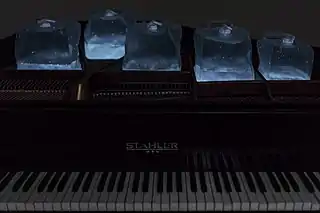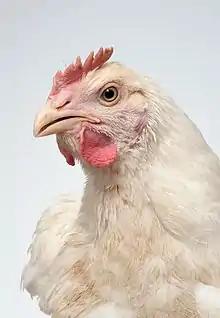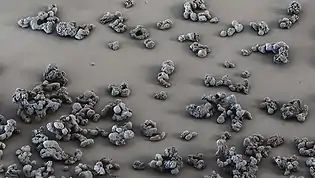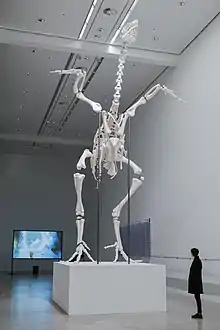Andreas Greiner
Andreas Greiner (born 1979) is an artist based in Berlin. He works with a wide range of different media including sculpture, installation, photography, video and techniques such as electron microscopy, algorithmic image creation and 3D printing. Frequently he works with biological and natural growth processes to create art works.[1] His approach addresses humanity’s relationship with its living and non-living environment and the nature–culture dichotomy.[2]
Throughout his career Greiner has cooperated with experts such as microbiologists, art historians, computer programmers, architects and artists, e.g. Ivy Lee Fiebig, Alexandra Spiegel[3] and the composers Tyler Friedman and Páll Ragnar Pálsson. He is part of two artist collectives: A/A (with Armin Keplinger) and Das Numen (with Julian Charrière, Markus Hoffmann and Felix Kiessling).[1][4]
Early life and education
Greiner was born in Aachen, Germany. In Florence and San Francisco he initially studied figurative drawing and sculpture to improve his understanding of the human figure and anatomy. Afterwards he studied medicine for three years in Budapest and Dresden. Returning to art at Berlin University of the Arts he enrolled first in multi-media art and later joined the Institute for Spatial Experiments.[1][4]
Work
Greiner’s work is informed by the natural sciences, technology and the humanities.[2][5] A central focus of his work is the human–nature relationship and the Anthropocene, as currently discussed in academia and in mainstream media.[6][7]
Living art and bioluminescence

By incorporating living beings as subjects in his work, Greiner questions the idea of art as man-made. Microorganisms make the outcome of the artwork unpredictable and this loss of control opposes the traditionally executive role of the artist.[1][8]
A characteristic of Greiner’s work is the cultivation of bioluminescent algae and other bioluminescent creatures.[9] When the water in which the organisms live is disturbed they produce bright blue specks. In a darkened exhibition space this effect has been produced mechanically by Greiner using musical instruments or gyroscopes to disturb the water's surface. Soundwaves have also been used to initiate bioluminescence in works accompanied by abstract musical pieces.[10] (see works The Molecular Ordering of Computational Plants, Multitudes, Dreamcatcher, 16 sqm).
Living sculpture

Greiner also highlights sculptural qualities of phenomena which are not usually associated with sculpture. Traditionally sculpture is a static medium formed from inanimate matter and Greiner seeks to expand this.[11] In the past he has demonstrated the plastic and sculptural qualities of an explosion (Entladung with Fabian Knecht, 2012–2013), of social interactions and of electron microscopies of unicellular organisms (Hybrid Matter).
Greiner has also framed animals as living sculptures. For example in Der freie Grundriss (2014) he placed a pupated fly maggot named Ludwig inside the Neue Nationalgalerie in Berlin (Festival of Future Nows). Once it hatched it became a ‘flying sculpture’. Its status as an art work was confirmed by the artistic director of the Neue Nationalgalerie by signing a contract with Greiner.[12][13] Another living sculpture conceptualised by Greiner was a hybrid broiler chicken from an industrial fattening plant northeast of Berlin, whom he named Heinrich (2015–2016). Greiner brought him to a suburban petting zoo in October 2015 where he died a few months later. His status as a ‘living sculpture’ was also confirmed with a contract between the petting zoo and Greiner.[1][8][14][15]

Study (Portrait) of the Singularity of the Animal
Study (Portrait) of the Singularity of the Animal (2015 – ongoing) is the title of a series of works exploring the genre of portraiture, altered (unnatural) nature and non-human life beyond human senses. Traditionally this genre has been used to express a human subject’s individuality, character and beauty.
By portraying and naming a set of algae Greiner highlights the individuality, character and specific aesthetics of these microorganisms (8 Heads High, Altered Morphologies). The portraits are made using a scanning electron microscope, making them appear three-dimensional and less abstract from everyday visual experience.[7][8] Other works using the electron microscope portray mutated cells, such as cancer cells and synthetically created bacterial cells. These contrasting types of mutations provoke the question of what is natural and where humans intervene in growing processes.[5][10]
Monument for the 308

Greiner’s work comments on contemporary issues but also seeks to explore possible futures in what he himself has called “archeology of the future”. This idea is recognisable throughout his work, but most prominently in his exhibition for the Museum Berlinische Galerie (2016–2017) or the ‘Kunsthalle‘ Meat Factory in Prague (2018), in which he constructed a monumental sculpture 3D printed from an X-ray scan of a dead-found broiler chicken in an industrial feeding plant (Monument for the 308).[2][14] This species of hybrid chicken—a modern biofact[16]—is artificially bred, sterile and one of the most consumed animals in the western world.[17] The 8 meter tall statue was meant to resemble a dinosaur in a natural history museum (see also Weltuntergang – Ende ohne Ende at Natural History Museum in Bern/Switzerland (2018–2019)). Just as dinosaurs are icons of prehistoric eras (Triassic-Cretaceous), Greiner conceives the broiler as an icon of the Anthropocene.[2][18][19]
Two years after Greiner exhibited the work, in December 2018, the Royal Society Open Science journal published an article by a group of geologists, paleobiologists and archaeologists, which asserted that common broiler chicken could be a potential paleo-biological marker for the changes brought about in the Anthropocene:
Changing patterns of human resource use and food consumption have profoundly impacted the Earth's biosphere. Until now, no individual taxa have been suggested as distinct and characteristic new morphospecies representing this change. Here we show that the domestic broiler chicken is one such potential marker. [...] Physical and numerical changes to chickens in the second half of the twentieth century, i.e. during the putative Anthropocene Epoch, have been the most dramatic, with large increases in individual bird growth rate and population sizes. Broiler chickens, now unable to survive without human intervention, have a combined mass exceeding that of all other birds on Earth; this novel morphotype symbolizes the unprecedented human reconfiguration of the Earth's biosphere.”[20]
Collective exhibitions
- Dominions, collaboration with Julian Charrière, curated by Carson Chan, Program e.V. Berlin (DE), 2011[4]
References
- Dell, April. "Andreas Greiner" Archived 2018-12-05 at the Wayback Machine, Berlin Art Link, retrieved 18 December 2018.
- Rosenbaum, Julia. "Andreas Greiner" Archived 2019-09-25 at the Wayback Machine, Collectors Agenda, retrieved 3 January 2018.
- Kunst-am-Bau-Wettbewerb Archived 2019-03-31 at the Wayback Machine, UN Campus bonn, retrieved 31 March 2019.
- Andreas Greiner CV, Dittrich&Schlechtriem, retrieved 15 December 2018.
- Andreas Greiner Exhibitions, Dittrich&Schlechtriem, retrieved 15 December 2018.
- Wischnewski, Manuel. "Wenn Museen und Markt sich verbünden", Die Welt, 27 August 2016.
- Kovacs, Nora. "Exhibition // A Requiem for the Living: Andreas Greiner’s Multitudes at Import Projects" Archived 2018-01-16 at the Wayback Machine, Berlin Art Link, 21 April 2015.
- Rhoades, Alison. "The Singularity Of The Chicken" Archived 2019-03-21 at the Wayback Machine, LOLA, retrieved 15 December 2018
- Rodríguez Fernández, Clara. "Giant Chickens and Bioluminescent Squids Invade Berlin", Labiotech.eu, 21 January 2017
- Brockschmidt, Annika. "Zurück in das Dunkel der Ozeane" Archived 2018-06-12 at the Wayback Machine, Der Tagesspiegel, 11 June 2018 10:10.
- Ströbele, Ursula. Man Beast Plant: Human and Non-human Living Sculptures. 2016, in: Stefan Vicedom (ed.), Andreas Greiner. Anatomy of a Fairy Tale, Wien: Verlag für Moderne Kunst, pages 71–108.
- Förster, Desiree. Being Interspecies: negotiation processes of subjectivity and the event beyond representation. 2016, in: Stefan Vicedom (ed.), Andreas Greiner. Anatomy of a Fairy Tale, Wien: Verlag für Moderne Kunst, pages 181–199.
- Ströbele, Ursula. Performing the making: die Eigenzeit der "lebenden Skulptur" zwischen Dauer und Augenblick. 2017, In: dies. / Guido Reuter (ed.), Skulptur und Zeit im 20. und 21. Jahrhundert, Cologne: Böhlau Verlag, pages 143–160.
- Meixner, Christiane. "Monument für ein Masthuhn" Archived 2018-06-14 at the Wayback Machine, Der Tagesspiegel, 13 September 2016 12:42.
- Scheder, Beate. "Animal Lovers und Andreas Greiner", Zitty, 14 November 2016 16:02.
- Karafyllis, Nicole C. Biofakte—Grundlagen, Probleme und Perspektiven, in: Erwägen Wissen Ethik (EWE) vol. 17, no.4 (2006), pages 547–558.
- "U.S. Broiler Industry Structure", National Agricultural Statistics Service (NASS), Agricultural Statistics Board, U.S. Department of Agriculture, released 27 November 2002
- "GASAG Art Prize 2016", Berlinische Galerie, retrieved 15 December 2018.
- "Andreas Greiner: Monument for the 308", MeetFactory, retrieved 15 December 2018.
- Carys E. Bennett, Richard Thomas, Mark Williams, Jan Zalasiewicz, Matt Edgeworth, Holly Miller, Ben Coles, Alison Foster, Emily J. Burton and Upenyu Marume. "The broiler chicken as a signal of a human reconfigured biosphere", The Royal Society Publishing, 12 December 2018. Archived 23 January 2019 at the Wayback Machine